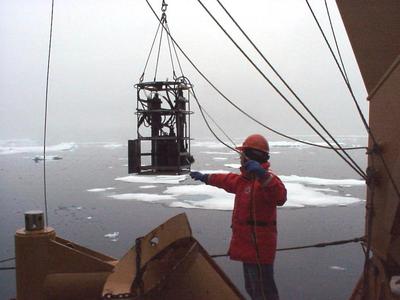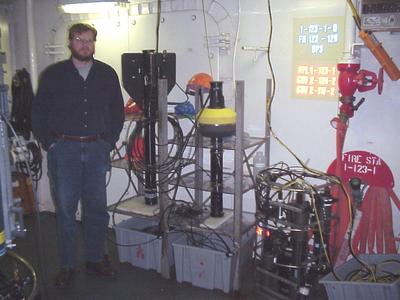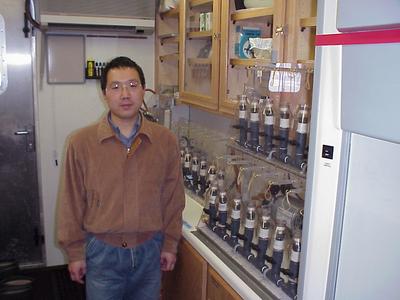15 August, 2002
As I mentioned before, the science service team all work regular 12 hour
shifts. The only other scientists on board who work regular hours are Dave
Ruble, Zhi-Ping Mei, and Xiao-ju Pan. Their optics work is always done at
the same time each day, as close to 8 AM as possible, following the daily
light cycle. Dave is a research associate working with Glenn Cota at Old
Dominion University in Norfolk, Virginia where Zhi-Ping is doing
postdoctoral work in oceanography and Xiao-ju is a graduate student. They
are interested in the primary productivity of phytoplankton and bio-optics
in the waters of the Arctic Ocean. Remember that phytoplankton are tiny
unicellular plants suspended in the ocean. They turn the CO2 in the water
(inorganic carbon) into organic carbon during photosynthesis. That means
that the phytoplankton are the primary (first) producers (they produce food
for themselves and for others) in the ocean. In order to study primary
production, this team collects water samples from the euphotic zone and does
a series of measurements of light penetration (how deep it goes) into the
water.
Dave's sampling is for passive optics. He begins sampling each day with two
instruments that he puts into the water. One remains on the surface as a
reference and the other goes past the 1% of surface light level. At that
depth, less than 1% of the surface light is reaching into the water. Dave's
instrument measures the visible spectrum of light in the water that is both
coming from the sun and back out to the surface. He's trying to get a
relationship between the amount of chlorophyll (phytoplankton contain
chlorophyll) and the color of the ocean. When the skies are very clear and
we have open water (no ice) for 10 kilometers, and a satellite is passing
over within a two hour time span, Dave can use his data to validate the
satellite data. Needless to say, with all our foggy weather and ice, that
has not happened yet on this cruise! If they can get this data, they will
be able to calculate how the phytoplankton here in the Arctic Ocean absorb
light and reflect it. These calculations have been done for lower latitude
oceans, but only a limited amount have been done in the Arctic. One
interesting note is that Dave can also measure the visible spectrum of light
reflected from the sea surface with a sensor on the flying bridge (high on
the ship outside the bridge). That usually works best in bright sunlight,
but he has managed to get a few good readings even though we've had so many
overcast and foggy days.
There's another part to this team's work, and that is called active optics.
Each morning when Dave and Xiao-ju place another large piece of equipment
into the water they are actually using three instruments in one package.
The first one measures the attenuation (decrease) of light and how much
light is absorbed by the water, parcticles, and dissolved materials in the
water. They can then calculate to find out how much light is scattered by
the parcticles in the water. The second instrument measures how much light is
absorbed only by what is dissolved in the water, and the third measures the
light which bounces back because of the parcticles in the water. All these
measurements provide more information about light in the water column.
Xiao-ju works with still another sample from the CTD productivity cast. He
is checking for light absorption by parcticulate (parcticles) and soluble
(dissolved) matter in the water, and he's trying to find out how much light
is absorbed by the phytoplankton in the water and how much is absorbed by
other materials. This gives him information to better understand the
relationship between light attenuation and the amount of phytoplankton in
the water column.
The team always tries to do their optics sampling at the same time as a
special CTD cast called a productivity cast. They take water samples from
that cast in order to measure the chlorophyll present. They also incubate
the water for 6 hours and for 24 hours in a chamber that mimics the
different light levels at the surface and at five lower depths, down to the
1% light penetration level. They add a special radioisotope, carbon-14, to
the samples. The phytoplankton take up the carbon-14 just as they would
take up naturally existing inorganic carbon. After a set time, Zhi-ping
filters all the water and dries the filters to preserve them. He can later
analyze them for the presence of carbon-14 to give him an idea of the growth
of the phytoplankton. Both Zhi-ping and Xiao-ju are also responsible for
another experiment involving the water in the incubators. They use two
stable isotopes, nitrogen-15 and carbon-13, to measure how nutrients are
taken up by the phytoplankton in the water. This is all a part of
understanding the way nitrogen moves through the food chain.
All the work that this team is doing is designed to give them information
about primary production in the entire euphotic zone (where light reaches).
It's easy to see how this ties in with the rest of the work on board.
Primary production is the first step in changing the carbon from the water
into a form that organisms can use. The amount of that production is
critical for all life in the ocean. In addition, phytoplankton production
reduces CO2 in the surface water in direct contact with the atmosphere. When
CO2 in the water is lower than that in the atmosphere, atmospheric CO2, a
greenhouse gas that is responsible for global warming, could be drawn into
the seawater. Therefore, studies on primary production are also critical in
understanding the role of oceans in slowing global warming. The bio-optic
data will be used to establish mathematical relationships between satellite
ocean color images and phytoplankton biomass and production. Therefore, in
the future we could obtain large-scale information of primary production in
the Arctic Ocean from space.

<> Xiao-ju Pan measures active optics with this suite of three instruments that go into the water together.

<> Dave is standing next to (left to right) the two passive optics instruments and the small instrument that looks like a cage that measures passive optics.

<> Xiao-ju Pan spends much of his time in this lab filtering the water from the incubators.

<> Zhi-ping Mei is standing next to the incubators on the bow where they incubate water from the CTD productivity cast. The chamber mimics different light levels at the surface and at five lower depths.

The instrument that Dave Ruble is carrying measures the visible spectrum of light in the water that is both coming from the sun and back out to the surface. The instrument goes into the water past the 1% of surface light level.
Contact the TEA in the field at
.
If you cannot connect through your browser, copy the
TEA's e-mail address in the "To:" line of
your favorite e-mail package.
|
